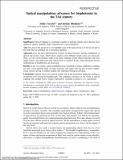Files in this item
Optical manipulation : advances for biophotonics in the 21st century
Item metadata
| dc.contributor.author | Corsetti, Stella | |
| dc.contributor.author | Dholakia, Kishan | |
| dc.date.accessioned | 2021-08-03T16:30:02Z | |
| dc.date.available | 2021-08-03T16:30:02Z | |
| dc.date.issued | 2021-07 | |
| dc.identifier | 275308581 | |
| dc.identifier | fc4c8a7a-9394-42d7-890b-dfe142d2d3e2 | |
| dc.identifier | 85110950124 | |
| dc.identifier | 000680424400002 | |
| dc.identifier.citation | Corsetti , S & Dholakia , K 2021 , ' Optical manipulation : advances for biophotonics in the 21st century ' , Journal of Biomedical Optics , vol. 26 , no. 7 , 070602 . https://doi.org/10.1117/1.JBO.26.7.070602 | en |
| dc.identifier.issn | 1083-3668 | |
| dc.identifier.other | RIS: urn:0293DB7FA06A2958968A6BDC403850A2 | |
| dc.identifier.uri | https://hdl.handle.net/10023/23706 | |
| dc.description | We thank the UK Engineering and Physical Sciences Research Council for funding (Grant Nos. EP/P030017/1 and EP/R004854/1). | en |
| dc.description.abstract | Significance: Optical trapping is a technique capable of applying minute forces that has been applied to studies spanning single molecules up to microorganisms. AIM: The goal of this perspective is to highlight some of the main advances in the last decade in this field that are pertinent for a biomedical audience. Approach: First, the direct determination of forces in optical tweezers and the combination of optical and acoustic traps, which allows studies across different length scales, are discussed. Then, a review of the progress made in the direct trapping of both single-molecules, and even single-viruses, and single cells with optical forces is outlined. Lastly, future directions for this methodology in biophotonics are discussed. Results: In the 21st century, optical manipulation has expanded its unique capabilities, enabling not only a more detailed study of single molecules and single cells but also of more complex living systems, giving us further insights into important biological activities. Conclusions: Optical forces have played a large role in the biomedical landscape leading to exceptional new biological breakthroughs. The continuous advances in the world of optical trapping will certainly lead to further exploitation, including exciting in-vivo experiments. | |
| dc.format.extent | 23 | |
| dc.format.extent | 2770992 | |
| dc.language.iso | eng | |
| dc.relation.ispartof | Journal of Biomedical Optics | en |
| dc.subject | Biophotonics | en |
| dc.subject | Light | en |
| dc.subject | Optical manipulation | en |
| dc.subject | Optical tweezers | en |
| dc.subject | Optics | en |
| dc.subject | Trapping | en |
| dc.subject | QC Physics | en |
| dc.subject | QH301 Biology | en |
| dc.subject | T-NDAS | en |
| dc.subject.lcc | QC | en |
| dc.subject.lcc | QH301 | en |
| dc.title | Optical manipulation : advances for biophotonics in the 21st century | en |
| dc.type | Journal article | en |
| dc.contributor.sponsor | EPSRC | en |
| dc.contributor.sponsor | EPSRC | en |
| dc.contributor.institution | University of St Andrews. School of Physics and Astronomy | en |
| dc.contributor.institution | University of St Andrews. Sir James Mackenzie Institute for Early Diagnosis | en |
| dc.contributor.institution | University of St Andrews. Centre for Biophotonics | en |
| dc.contributor.institution | University of St Andrews. Biomedical Sciences Research Complex | en |
| dc.identifier.doi | https://doi.org/10.1117/1.JBO.26.7.070602 | |
| dc.description.status | Peer reviewed | en |
| dc.identifier.grantnumber | EP/P030017/1 | en |
| dc.identifier.grantnumber | EP/R004854/1 | en |
This item appears in the following Collection(s)
Items in the St Andrews Research Repository are protected by copyright, with all rights reserved, unless otherwise indicated.

